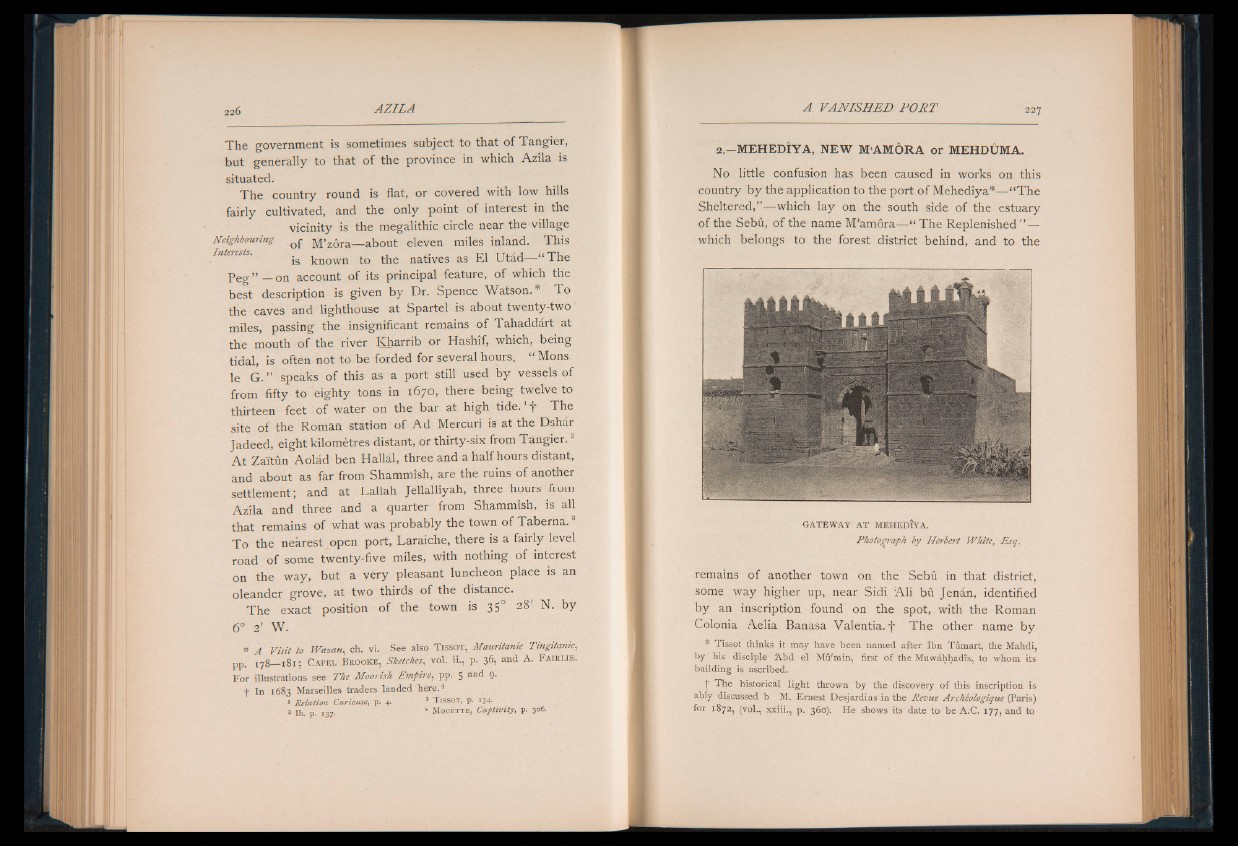
The government is sometimes subject to that of Tangier,
but generally to that of the province in which Azila is
situated.
The country round is flat, or covered with low hills
fairly cultivated, and the only point of interest in the
vicinity is the megalithic circle near the village
Neighbouring of M’zôra—-about eleven miles inland. This
is known to the natives as El Utâd— “ The
P e g ” — on account of its principal feature, of which the
best description is given by Dr. Spence Watson.* To
the caves and lighthouse at Spartel is about twenty-two
miles, passing the insignificant remains of Tahaddart at
the mouth of the river Kharrib or Hashif, which, being
tidal, is often not to be forded for several hours. “ Mons.
le G . ” speaks of this as a port still used by vessels of
from fifty to eighty tons in 1670, there being twelve to
thirteen feet of water on the bar at high tide, j- The
site of the Roman station of A d Mercuri is at the Dshâr
Jadeed, eight kilomètres distant, or thirty-six from Tangier.2
A t Zaïtûn Aolâd ben Hallai, three and a half hours distant,
and about as far from Shammîsh, are the ruins of another
settlement; and at L a l la h Jellallîyah, three hours from
Azila and three and a quarter from Shammîsh, is all
that remains of what was probably the town of Taberna.1
To the neàrest open port, Laraiche, there is a fairly level
road of some twenty-five miles, with nothing of interest
on the way, but a very pleasant luncheon place is an
oleander grove, at two thirds of the distance.
The exact position of the town is 350 28' N. by
6° 2' W.
* A Visit to Wazan, ch. vi. See also T is so t , Mauritanie Tingitanie,
pp. 178 1 8 1 ; C a p e l B r o o k e , Sketches, v o l . i i. , p. 36, an d A. F a ir l ie .
For illustrations see The Moorish Empire, pp. 5 and 9.
f In 1683 Marseilles traders landed here.4
1 Relation Curieuse, p . 4. 1 T i s s o t , p . 134.
3 Jb p. J3?. 4 M o u e t t e , Captivity, p . 306.
2— MEHEDIYA, NEW M’AMORA or MEHDUMA.
No little confusion has been caused in works on this
country by the application to the port of Mehediya*— “ The
Sheltered,”— which lay on the south side of the estuary
of the Sebu, of the name M'amora— “ The Replenished” —
which belongs to the forest district behind, and to the
G A TEW A Y A T MEHEDIYA.
Photograph by Herbert White, Esq.
remains of another town on the Sebû in that district,
some way higher up, near Sidi A li bû Jenân, identified
by an inscription found on the spot, with the Roman
Colonia Aelia Banasa Valentia. f The other name by
* Tissot thinks it may have been named after Ibn Tumart, the Mahdi,
by his disciple Abd el Mu'min, first of the Muwâhhadîs, to whom its
building is ascribed.
f The historical light thrown by the discovery of this inscription is
ably discussed b M. Ernest Desjardins in the Revue Archéologique (Paris)
for 1872, (vol., xxiii., p. 360). He shows its date to be A.C. 177, and to